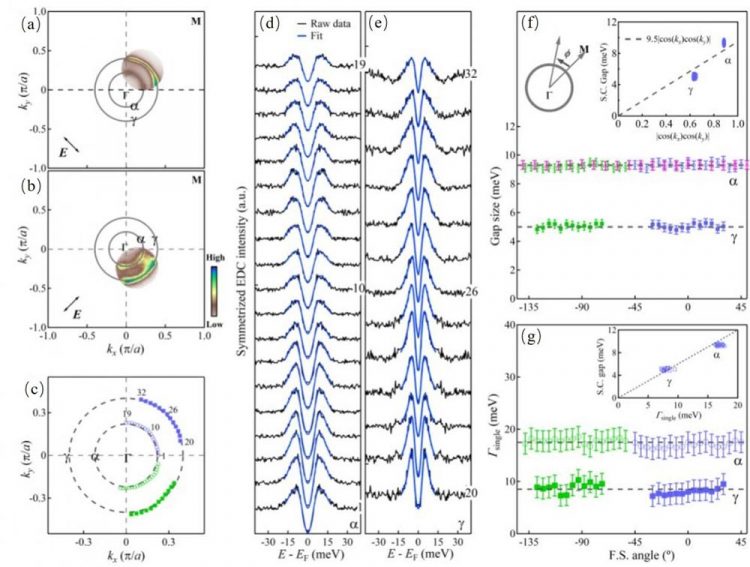Electronic evidence of non-Fermi liquid behaviors in an iron-based superconductor

Recently, a research team led by Prof. Xingjiang Zhou from Institute of Physics, Chinese Academy of Sciences, has conducted high-resolution laser-based ARPES experiments on the superconducting gap and electronic structure in the optimally-doped (Ba0.6K0.4)Fe2As2 superconductor. Credit: ©Science China Press
In conventional superconductors, superconductivity emerges from the normal state where the low energy excitations can be well described by the Fermi liquid theory. In the normal state, there is a well-defined Fermi surface and well-defined quasiparticles on the Fermi surface.
Superconductivity is realized by the instability of the Fermi surface and formation of electron Cooper pairs along the Fermi surface. In high temperature cuprate superconductors, particularly in the underdoped region, there is no well-defined Fermi surface formed near the antinodal region and Fermi arcs or Fermi pockets are formed due to the occurrence of the pseudogap in the normal state.
The electronic state near the antinodal region is highly incoherent in the normal state without formation of quasiparticles. Such an extreme normal state electronic structure, with neither well-defined Fermi surface nor quasiparticles, has posed a challenge in understanding its underlying origin and the emergence of superconductivity from such an unusual normal state.
Between the two extreme cases of conventional superconductors and cuprate superconductors, it is intriguing to ask whether it is possible to have a scenario that superconductivity can be realized in a system that has well-defined Fermi surface but without quasiparticles in the normal state. If there is such a case, how about its superconducting properties and superconductivity mechanism?
The iron-based superconductors show some similarities and differences when compared with cuprates, and many discussions have been focused on their non-Fermi liquid normal state. However, direct spectroscopic evidence of the non-Fermi liquid normal state behaviors is still lacking. Recently, a research group led by Prof. Xingjiang Zhou from Institute of Physics, Chinese Academy of Sciences, has shown clear electronic evidence of non-Fermi liquid behaviors in an iron-based superconductor and established a new superconducting system where there is a well-defined Fermi surface but no quasiparticles in the normal state.
They carried out high resolution laser-based angle-resolved photoemission (ARPES) measurements on a prototypical iron-based superconductor, the optimally-doped (Ba0.6K0.4)Fe2As2. First, they found that the superconducting gap is Fermi surface dependent along two hole-like pockets around the Brillouin zone center in (Ba0.6K0.4)Fe2As2 which is consistent with ARPES results by helium lamp and synchrotron radiation light sources but in contradiction with a previous laser-based ARPES results.
This result has solved a long-standing controversy about the superconducting gap structure in this prototypical iron-based superconductor. Second, they found that, while sharp superconducting coherence peaks emerge in the superconducting state, the normal state becomes fully incoherent with no quasiparticles along a well-defined Fermi surface.
This has provided direct spectroscopic evidence that the normal state is a non-Fermi liquid. It has also established that (Ba0.6K0.4)Fe2As2 superconductor is a new system where its normal state has a well-defined Fermi surface but without well-defined quasiparticles along the Fermi surface.
Third, the superconducting gap exhibits an unusual behavior that it is nearly constant in the entire superconducting state but drops abruptly to zero at the superconducting transition temperature; this is inconsistent with the conventional BCS picture.
The spectral weight near the Fermi level is not conserved when the sample evolves from the normal state into the superconducting state. These results will provide key insights in understanding the superconductivity mechanism in iron-based superconductors, and in particular, how the coherent superconducting state can emerge out of the fully incoherent normal state in unconventional superconductors.
###
This work is supported by the National Key Research and Development Program of China (Grant No. 2016YFA0300300, 2017YFA0302900), the Strategic Priority Research Program (B) of the Chinese Academy of Sciences (Grant No. XDB07020300, XDB25000000), the National Basic Research Program of China (Grant No. 2015CB921000), the National Natural Science Foundation of China (Grant No. 11334010), and the Youth Innovation Promotion Association of CAS (Grant No. 2017013).
See the article:
Jianwei Huang, Lin Zhao, Cong Li, Qiang Gao, Jing Liu, Yong Hu, Yu Xu, Yongqing Cai, Dingsong Wu, Ying Ding, Cheng Hu, Huaxue Zhou, Xiaoli Dong, Guodong Liu, Qingyan Wang, Shenjin Zhang, Zhimin Wang, Fengfeng Zhang, Feng Yang, Qinjun Peng, Zuyan Xu, Chuangtian Chen and Xingjiang Zhou. Emergence of Superconductivity from Fully Incoherent Normal State in an Iron-Based Superconductor (Ba0.6K0.4)Fe2As2. Sci. Bull, 2018, doi: 10.1016/j.scib.2018.11.017
https:/
Media Contact
More Information:
http://dx.doi.org/10.1016/j.scib.2018.11.017All latest news from the category: Physics and Astronomy
This area deals with the fundamental laws and building blocks of nature and how they interact, the properties and the behavior of matter, and research into space and time and their structures.
innovations-report provides in-depth reports and articles on subjects such as astrophysics, laser technologies, nuclear, quantum, particle and solid-state physics, nanotechnologies, planetary research and findings (Mars, Venus) and developments related to the Hubble Telescope.
Newest articles

NASA: Mystery of life’s handedness deepens
The mystery of why life uses molecules with specific orientations has deepened with a NASA-funded discovery that RNA — a key molecule thought to have potentially held the instructions for…

What are the effects of historic lithium mining on water quality?
Study reveals low levels of common contaminants but high levels of other elements in waters associated with an abandoned lithium mine. Lithium ore and mining waste from a historic lithium…

Quantum-inspired design boosts efficiency of heat-to-electricity conversion
Rice engineers take unconventional route to improving thermophotovoltaic systems. Researchers at Rice University have found a new way to improve a key element of thermophotovoltaic (TPV) systems, which convert heat…



